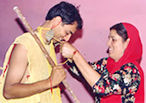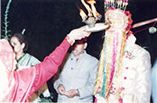
 Kullu
marriages are solemnized according to the Brahmin tradition. The
priest fixes an auspicious day for the wedding after consulting
the jantri (astrological calendar). He fixes the dates for barat
(wedding procession), lagan (the time when the groom enters the
bride's house) and vadhu pravesh (the bride enters the groom's
house for the first time). Days are also fixed for cutting wood
for preparing feast and buying clothes. A few days before the
wedding, lagnotri (list of lagnas involved in a wedding) is fixed.
Once the lagnotri is fixed, the groom and the bride aren't allowed
to cross a river or brook.
Kullu
marriages are solemnized according to the Brahmin tradition. The
priest fixes an auspicious day for the wedding after consulting
the jantri (astrological calendar). He fixes the dates for barat
(wedding procession), lagan (the time when the groom enters the
bride's house) and vadhu pravesh (the bride enters the groom's
house for the first time). Days are also fixed for cutting wood
for preparing feast and buying clothes. A few days before the
wedding, lagnotri (list of lagnas involved in a wedding) is fixed.
Once the lagnotri is fixed, the groom and the bride aren't allowed
to cross a river or brook.

The four day long wedding starts with great fervor in the houses
of both bride and the bridegroom. The priest investitures the
bridegroom with the sacred thread, janeu. A ceremony is held to
prepare him to go into the grihasthashram (the domestic stage
of life after Brahmacharya). The priest chants a secret mantra
into the bridegroom's ear. After the pooja ceremonies are over
in the bride's and the bridegroom's house, they bathe with holy
water.
In the evening, the chota jagra is held. The bride's maternal
uncle gives her a nose ring and gifts to her family. He also arranges
a feast for the friends and relatives. The bridegroom is garlanded.
The near and dear give gifts to the bridegroom called 'tarmol'.

 After
the chhota jagra, the wedding procession (barat) leaves for the
bride's house in the evening. People accompanying the procession
stay at the bride's place and celebrate the evening. Ganesha Pooja
is held and the grand feast called 'dham' is held. People who
attend the dham give gifts to the bride, which mainly consists
of money called 'bartan'. Next evening, the wedding procession
returns to the bridegroom's place alongwith the bride. The bride
is given a warm welcome. Next day dham is held in the bridegroom's
house. The wedding ends on the fourth day after the feast called
Dhamdu.
After
the chhota jagra, the wedding procession (barat) leaves for the
bride's house in the evening. People accompanying the procession
stay at the bride's place and celebrate the evening. Ganesha Pooja
is held and the grand feast called 'dham' is held. People who
attend the dham give gifts to the bride, which mainly consists
of money called 'bartan'. Next evening, the wedding procession
returns to the bridegroom's place alongwith the bride. The bride
is given a warm welcome. Next day dham is held in the bridegroom's
house. The wedding ends on the fourth day after the feast called
Dhamdu.
In ancient times, polygamy was an accepted custom. But these
days, with the change of social and economic conditions and the
exposure to outside world, this practice is being discouraged.
In some remote parts like Malana, "bride swapping" was
also practiced. But with the increasing awareness, these customs
are towards decline.

